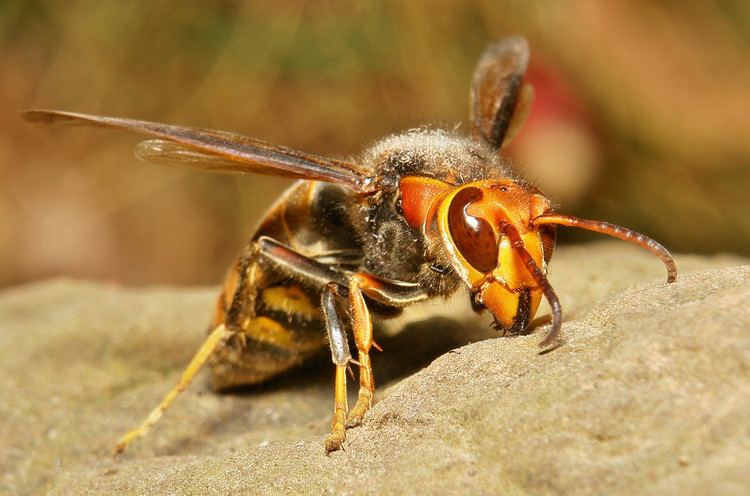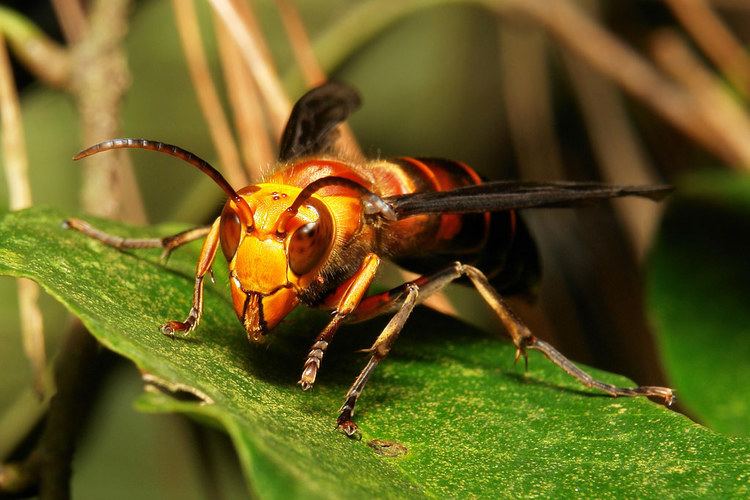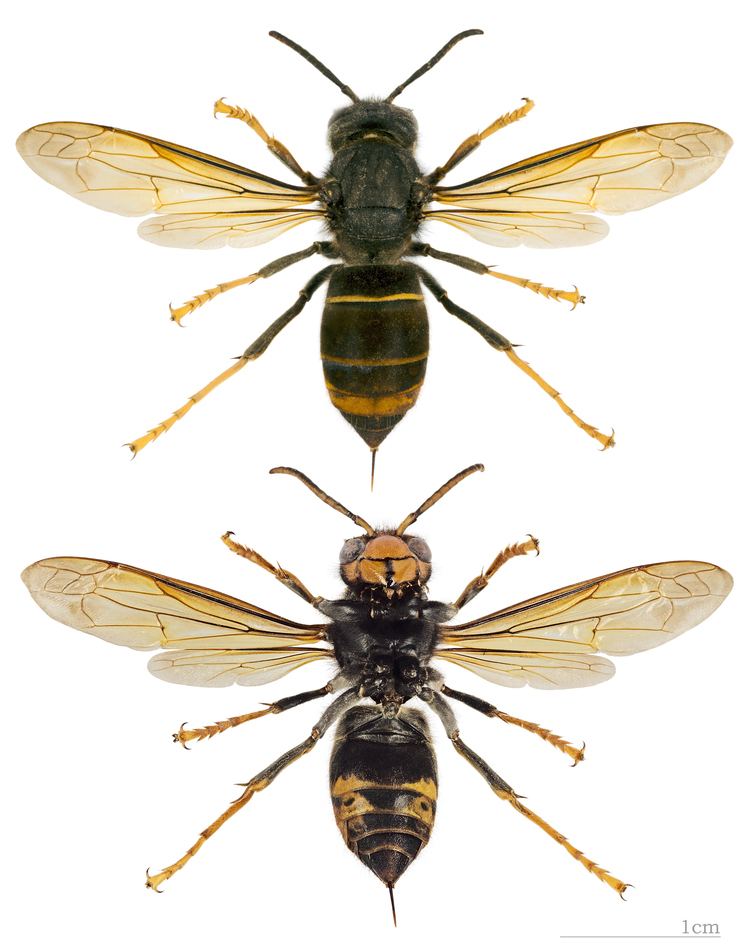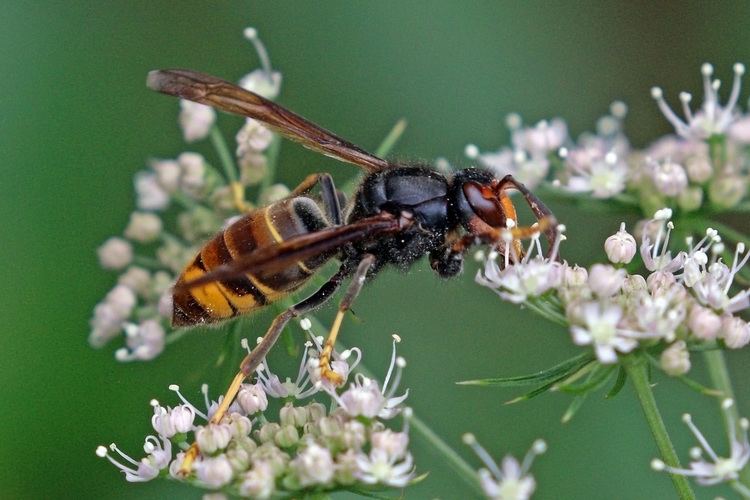Subfamily Vespinae Rank Species | Genus Vespa Higher classification Hornet | |
 | ||
Length Female: 2 cm (Adult, Worker) Similar Hornet, European hornet, Insect, Asian giant hornet, Vespidae | ||
The Asian predatory wasp, also known as the Asian hornet or yellow-legged hornet (Vespa velutina), is a species of hornet indigenous to Southeast Asia. It is of concern as an invasive species in some other countries.
Contents
- A giant hornet wasp asian predatory wasp banded polistes sri lanka
- Appearance
- Biology
- Distribution
- Pest status and invasiveness
- References

A giant hornet wasp asian predatory wasp banded polistes sri lanka
Appearance

Vespa velutina is slightly smaller than the European hornet. Typically queens are 30 mm in length, and males about 24 mm. Workers measure about 20 mm in length. The species has distinctive yellow tarsi (legs). The thorax is a velvety brown or black with a brown abdomen. Each abdominal segment has a narrow posterior yellow border, except for the fourth segment, which is orange. The head is black and the face yellow. Regional forms vary sufficiently in colour to cause difficulties in classification, and several subspecies have been variously identified or rejected. The form that is causing concern about its invasiveness in Europe is Vespa velutina nigrithorax.
Biology

Like other hornets, Vespa velutina builds nests that may house colonies of several thousand individuals. Females in the colony are armed with formidable stingers with which they defend their nests and kill their prey. The nest is of paper, roughly in the shape of a huge egg, usually at least half a metre in length. Unlike the nest of the European hornet, Vespa crabro, its exit is usually lateral rather than at the bottom. The nesting season is long, and a colony commonly begins by building a nest in a low shrub, then abandoning it after some months and rapidly building a new one high in a tree, possibly as an anti-parasitic measure. The next generation of young queens disperses in the late autumn to hibernate over winter.
Vespa velutina opportunistically hunts a very wide range of insects, including flies, dragonflies and Orthoptera, typically capturing them by pursuit. The major concern about their invasiveness however, is that when they find a bee colony or an apiary, they tend to settle down and specialise in honeybees as their prey. A hornet occupies a position above a beehive as its hunting territory. It flies about within an area of about half a square metre, scanning the direction from which foraging bees return to the hive. Each hornet vigorously defends its hunting territory, chasing off any rivals. However, as soon as it catches a bee it flies off and another hornet replaces it, usually within a few seconds. The circadian activities of the two species of honeybees are similar, and the hunting hornets match them; their most intense activity is in the morning and afternoon, not near dusk or noon.

In their native range Vespa velutina mainly hunt Apis cerana, the Eastern honey bee, which has evolved a strategy of avoiding hovering hornets by rapid entry and exit from the hive when hornets are about. The guard bees also ball hornets to death. However, where the European honey bee has been imported, Vespa velutina finds them easier prey than Apis cerana because Apis mellifera have not been subjected to selection for countering concentrated hawking by hornets. For example, Apis mellifera approach their hives more indirectly and slowly when they detect hawking hornets, instead of darting in as fast as possible in the way that Apis cerana does. They also ball hornets to death in the way that Apis cerana do, but less effectively, and they do not achieve as high a temperature in the ball. Furthermore, when they detect that hornets are hawking, Apis cerana tend to withdraw into the nest and Apis mellifera do not.

Apis cerana guard bees also use wing shimmering in response to the presence of Vespa velutina. This is a very generalised response to disturbance and has variously been suggested to be an aposematic signal or a strategy for disruption of visual patterns, similar to the behaviour of Apis nuluensis and Apis dorsata. Apis mellifera exhibits no such behaviour. In any event, when Apis mellifera occur together with Apis cerana. Vespa velutina preferentially hawk Apis mellifera foragers.
Distribution
Vespa velutina originates from Southeast Asia, particularly the tropical regions, from Northern India, Pakistan, Afghanistan, Bhutan, China, Taiwan, Burma, Thailand, Laos, Vietnam, Malaysia, the Indo-Chinese peninsula and surrounding archipelagoes.
As an invader the hornet has appeared in France, Spain, Portugal, South Korea and Japan. Further invasions are expected in various countries including much of Europe. A nest was reported on the Channel Island of Alderney in 2016. The first sighting on the UK mainland was announced on 20 September 2016 and occurred near Tetbury in Gloucestershire.
Pest status and invasiveness
Vespa velutina has become an invasive species in France where it is believed to have arrived in boxes of pottery from China in 2004. Humans have been attacked after disturbing hornets; although the species is not aggressive it "charges in a group as soon as it feels its nest is threatened". People have been hospitalised in France after suffering anaphylactic shock as a result of multiple stings. Because of hornets' larger size, their sting is more serious than that of a bee. By 2009 there were several thousand nests in the area of Bordeaux and surrounding departments, and by the end of 2015 they were reported over most of France.
The hornet spread to northern Spain, as confirmed in 2010 by the Beekeepers' Association of the Basque Country (Gipuzkoako Erlezainen Elkartea) and the Neiker entomology institute in Irún, after breeding colonies were found. It reached Portugal in 2011.
El País newspaper carried an article in its October 6, 2013 edition that the hornet had been spotted in Val d'en Bas, Garrotxa, Catalonia, in the foothills of the Pyrenees. Efforts were made to locate the nests before the insects hibernate in November. After foot patrols failed to track the hornets down, a helicopter equipped with a thermal camera was making sweeps over the area. The flights during the morning chill, attempted to find the nest's 'heat signature' against the colder background. In September 2013, a beekeeper from Rasines, Cantabria documented the hornets' presence in 2 specimens. In June 2015, firemen pulled a nest of the hornet above a building entrance in Santander.
The hornet has been reported as naturalised on the Japanese island of Tsushima since about 2010 .
